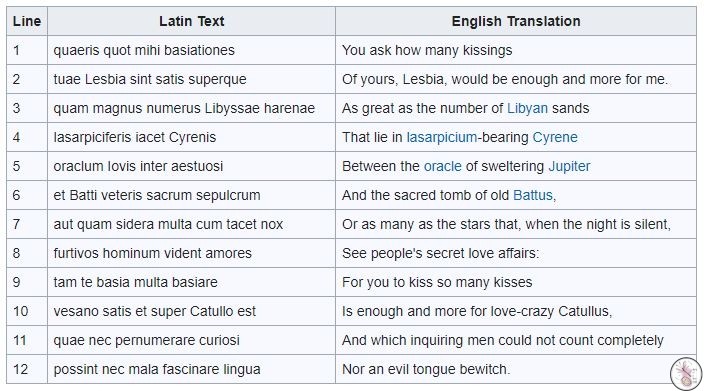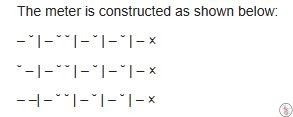Well, that’s not the most exciting heading I’ve ever come up with for a post, is it! Never mind, we must appease the algorithm and search engine gods, and if – like me – you’ve spent what feels like months of your life trying to figure out resources for the OCR GCSE Latin course, with no mock exams to fall back on – then you’ll be searching for something dull like ‘Resources for Verse A 2023/2024’. Our little four person study group for this year’s Latin exam has been researching and trying to make head and/or tails from the resources available, so here’s a little round up for you on what we’ve found. If you know of anything else, or can see gaps or where we’re going wrong, please do leave a comment and let us know!
Resources for How Many Kisses
- Firstly, the poem. We started off by reading it in ‘plain’ English, so that we can understand the broader themes. We also had it read to us in an older man voice, similar to that of the poet himself, one could imagine, with all the passions and inflections of an old poet. I particularly liked the pictures with it as it helps the student visualise what’s being spoken about. The Youtube video (below) description also explains more of the back ground to each of the pictures, which is helpful for contextualisation.
There’s another version of the Latin here: How many kisses – Pantheon Poets | Latin Poetry Recited and Translated
2. Our next task was to translate it for ourselves so that we knew what each word meant. Obviously this left a few variations on the translation, especially for words we were using Google Translate on, but still, it’s important to know the meaning of individual words. This is a line-by-line translation of Gaius Valerius Catullus 7 aka How Many Kisses from Wikipedia.
3. It seemed important at this point to be able to understand the contexts. The same Wikipedia link here was very helpful!
- Libya is not the modern day Libya, but Africa, which the romans called Libya.
- ‘as great a number of of the Libyan sands‘ was a common metaphor for infinity, just like today we might say ‘I *something something* as much as all the stars in the sky or all the sands on all the beaches’.
- silphium bearing – a herb that today we may know as asa foetida – it’s sort of garlicky, but not, very pungent, and makes Indian food taste… Indian. It’s as yellow as turmeric, as smelly as garlic, as tasty as salt. You don’t know that it’s in your Indian food, but once you know it, you know when you don’t have it in your food. It’s a spice that makes other spices shine. Anyway. Most people still don’t know what asa foetida is, and definitely don’t know what silphium is. In this case, however, the gum wasn’t an edible, so much as a cure for baldness, other illnesses, and a contraceptive or abortifacient. Relative here, since we’re talking about love, lust and other adult themes.
- Battus – Battus was the founder of the city of Cyrene in what is now called Libya back in 700 BC. His ‘sacred tomb’ was 300 miles away from the Oracle of Jupiter (the main Roman god) and it was used as something of a Roman ‘vision quest’ as some Romans would venture off into the desert in the hopes of finding the tomb and ‘receiving a vision’ – I’d argue that is dehydration speaking, but that’s probably not exam relevant.
- It’s maybe worth mentioning here too that Cyrene is where the highly-esteemed-in-Roman-times poet Callimachus was from/connected to, and Callimachus was considered one of the chief elegiac poets in Roman times – and Catullus (who wrote this poem, imitated this elegiac style, so the reference to Battus could be a nod to this fact. As with a lot of poetry or even music, sometimes lines are a reference purely for those who know.
- Or as many as there are stars – a metaphor we still use today, and echoes the sentiment from the the previous idea of ‘grains of sand’.
- Inquiring men – a reference to the gossip present at the time of Catullus affair. If his affair was in fact with ‘Lesbia’ (a code name for a woman from the Isle of Lesbos?) who in this instance was believed to be ‘Clodia’ the wife of a senator of Rome, this would be potentially devastating and deadly to both of them.
- An evil tongue bewitch – “In witchcraft, it was believed that if the evil one had a specific number that was related to the victim, [in this case the number of kisses] then it would make the spell more effective. Catullus is urging Lesbia to kiss him so many times that any potential evil-doer would not be able to count them. This would also serve to quench Catullus’ lust for Lesbia.”
There’s a very good, accessible ’round up’ of ideas from the Latin Tutor, which I definitely recommend you take the time to read, especially the explanation of the word basationes.
For slightly different interpretations, have a look at this article on Ancient-Literature and yet another interpretation here.
4. Next a look at the poetic devices used in this poem. For this an understanding of English Literature analysis would be helpful. As our group haven’t done English GCSE yet we’re a bit on the back foot with this one, but hopefully my degree in English Language and Literature will help a little! If you’ve never done poetry analysis before, here’s a helpful free download from TES.
To analyse a poem (in English, and we’re using the same format here in Latin), we look at the subject, the theme, the tone, imagery, form and feeling. This worksheet lists questions for students to ask while analysing the poem, and provides an answer sheet with analysis for students to explore. It’s our own analysis and interpretations, so if you have any to add, let us know in the comments and we’ll add/adjust as appropriate.
When it comes to form it’s worth remembering that How Many Kisses is a Hendecasyllabic poem, which means “eleven syllables”. It is a bouncy metre used for fun and light hearted poems, so when a poem is hendecasyllabic it’s a good indicator as to the tone of the poem too – it is most likely humorous or in this case, tongue in cheek. 
5. Memorising – the one thing I’ve heard consistently from past Latin students is that it helps a lot memorising the poems for the exams so that you know the translations and the words. You only have an hour for this paper, so you don’t want to be wasting time trying to remember translations. Fortunately none of the poems How Many Kisses, Love Will Not Let The Poet Sleep, or Conflicting Emotions are very long, so that shouldn’t be a problem. To help, though, have a look at Quizlet for flashcards for each. How Many Kisses has one for analysis of words and phrases, but it also has one with questions and answers based on the text, which might be useful for exam-style questions. It also has the translations to help with the memorisations.
6. Background and context – these can be really useful for understanding more about a poem, and the poet. This article gives us background on Catullus – though you might want to read it first as it may not be entirely age appropriate.
I was going to do all three poems in one post, but it’s a bit long now! I’ll do similar, but updated for the different poems as we complete them.